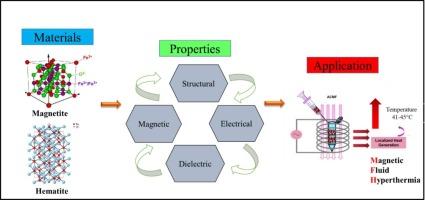Magnetic, electrical and induction heating properties of magnetite/hematite mixed phase nanoparticles
IF 3
3区 材料科学
Q3 MATERIALS SCIENCE, MULTIDISCIPLINARY
引用次数: 0
Abstract
Iron oxides in nanoform are associated with exciting properties for various applications such as energy storage, magnetic recording, biomedicine and sensing. These applications demand the tuning of the physico-chemical properties of iron oxide especially Fe3O4 phase. However, iron oxides generally exist in mixed phases of any of its mostly occurred three phases magnetite, maghemite and hematite. Here, we report a solvothermally processed mixed phase of magnetite and hematite nanoparticles (NPs) which has been prepared using P123 triblock copolymer in addition to urea and hexamethylenetetramine (HMTA). The magnetite phase crystallizes in inverse spinel structure of Fe3O4 whereas hematite (α-Fe2O3) phase crystallizes in corundum structure. The use of copolymer leads to flake-shaped morphology of nanoparticles whereas use of urea and HMTA in different ratio gives different proportion of magnetite and hematite. The mixed iron oxide nanoparticles (IONPs) possess significantly different magnetic, electrical and dielectric properties than their bulk analogue. The surface analysis confirms the presence of magnetite and hematite phase in all the samples attributed to the coexistence of Fe3+ and Fe2+ ions. FESEM micrographs shows evenly distributed nanoparticles but in aggregated form. Furthermore, due to their weakly ferromagnetic behaviour with magnetisation value of ∼55 emu/g at 1.5 kOe field, the nanoparticles exhibited good induction heating behaviour under AC magnetic field. As high as 472 W/g of specific absorption rate was attained at a nanoparticle concentration of 1 mg/mL in water.

磁铁矿/赤铁矿混合相纳米颗粒的磁性、电性和感应加热性能
纳米形式的氧化铁在储能、磁记录、生物医学和传感等各种应用中具有令人兴奋的特性。这些应用要求调整氧化铁特别是Fe3O4相的物理化学性质。而氧化铁一般以任何一种相的混相形式存在,多以磁铁矿、磁铁矿和赤铁矿三相形式存在。在这里,我们报道了一种溶剂热处理的磁铁矿和赤铁矿纳米颗粒(NPs)的混合相,它是用P123三嵌段共聚物以及尿素和六亚甲基四胺(HMTA)制备的。磁铁矿相结晶为Fe3O4的反尖晶石结构,赤铁矿(α-Fe2O3)相结晶为刚玉结构。共聚物的使用导致纳米颗粒的片状形貌,而尿素和HMTA的不同比例的使用会产生不同比例的磁铁矿和赤铁矿。混合氧化铁纳米颗粒(IONPs)具有明显不同的磁性,电学和介电性质比他们的块状类似物。表面分析证实,由于Fe3+和Fe2+离子共存,样品中均存在磁铁矿和赤铁矿相。FESEM显微图显示纳米颗粒分布均匀,但呈聚集状。此外,由于纳米颗粒的弱铁磁性,在1.5 kOe磁场下磁化值为~ 55 emu/g,因此在交流磁场下具有良好的感应加热性能。纳米颗粒在水中浓度为1 mg/mL时,比吸收率高达472 W/g。
本文章由计算机程序翻译,如有差异,请以英文原文为准。
求助全文
约1分钟内获得全文
求助全文
来源期刊

Journal of Magnetism and Magnetic Materials
物理-材料科学:综合
CiteScore
5.30
自引率
11.10%
发文量
1149
审稿时长
59 days
期刊介绍:
The Journal of Magnetism and Magnetic Materials provides an important forum for the disclosure and discussion of original contributions covering the whole spectrum of topics, from basic magnetism to the technology and applications of magnetic materials. The journal encourages greater interaction between the basic and applied sub-disciplines of magnetism with comprehensive review articles, in addition to full-length contributions. In addition, other categories of contributions are welcome, including Critical Focused issues, Current Perspectives and Outreach to the General Public.
Main Categories:
Full-length articles:
Technically original research documents that report results of value to the communities that comprise the journal audience. The link between chemical, structural and microstructural properties on the one hand and magnetic properties on the other hand are encouraged.
In addition to general topics covering all areas of magnetism and magnetic materials, the full-length articles also include three sub-sections, focusing on Nanomagnetism, Spintronics and Applications.
The sub-section on Nanomagnetism contains articles on magnetic nanoparticles, nanowires, thin films, 2D materials and other nanoscale magnetic materials and their applications.
The sub-section on Spintronics contains articles on magnetoresistance, magnetoimpedance, magneto-optical phenomena, Micro-Electro-Mechanical Systems (MEMS), and other topics related to spin current control and magneto-transport phenomena. The sub-section on Applications display papers that focus on applications of magnetic materials. The applications need to show a connection to magnetism.
Review articles:
Review articles organize, clarify, and summarize existing major works in the areas covered by the Journal and provide comprehensive citations to the full spectrum of relevant literature.
 求助内容:
求助内容: 应助结果提醒方式:
应助结果提醒方式:


